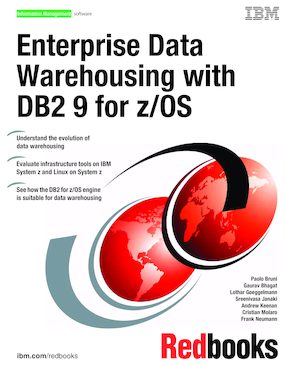Enterprise Data Warehousing with DB2 9 for z/OS
An IBM Redbooks publication
Note: This is publication is now archived. For reference only.

Published on 12 September 2008
ISBN-10: 0738431400
ISBN-13: 9780738431406
IBM Form #: SG24-7637-00
Authors: Paolo Bruni, Gaurav Bhagat, Lothar Goeggelmann, Sreenivasa Janaki, Andrew Keenan, Cristian Molaro and Frank Neumann
Enterprises look more and more to business intelligence (BI) to gain a competitive edge. Today's BI systems incorporate large data warehouses that are consolidated with near real-time operational data stores (ODS) and continuously updated from multiple sources. An increasing number of users in the enterprise want to access the data warehouse with BI applications with real-time needs.
There is a renewed interest in the ability to implement a data warehouse solution on DB2® for z/OS® and System z™. This is due to the inherent characteristics of security, availability, performance, mixed workload management, and the growing portfolio of data warehousing tools and functions provided by IBM®.
In this IBM Redbooks® publication, we focus on today's software components on System z and show how you can use them to realize the infrastructure for a full data warehouse solution. By using a retail business scenario loosely based on the TPC-H benchmark, we guide you through the warehouse implementation steps. In addition, we highlight the available methods, techniques, and technologies for the deployment of this solution, including reporting and analysis with Cognos 8 BI.
This book provides an opportunity for you to look at satisfying the operational needs of corporate users in addition to the longer term needs. In addition, business decision makers, architects, implementors, DBAs, and data acquisition specialists can use this book to gain a better understanding of how a data warehouse can be designed, implemented, and used.
Part 1. Data warehouse today
Chapter 1. Definitions
Chapter 2. Evolution of business intelligence
Chapter 3. Why implement a data warehouse on System z
Chapter 4. The architecture for the BI solution on System z
Part 2. Design and implementation of our warehouse scenario
Chapter 5. The business scenario and data models
Chapter 6. The system environment
Chapter 7. Functions in DB2 for z/OS for a data warehouse
Chapter 8. Q replication and event publishing
Chapter 9. Setting up ETL components for a data warehouse
Chapter 10. Full load using DataStage
Chapter 11. Incremental update with DataStage
Chapter 12. An operational business intelligence implementation
Chapter 13. Reporting and analysis with Cognos 8 BI
Chapter 14. Reporting with IBM DataQuant, QMF, and AlphaBlox
Part 3. Appendixes
Appendix A. Index compression jobs
Appendix B. Schema definitions
Appendix C. Additional material